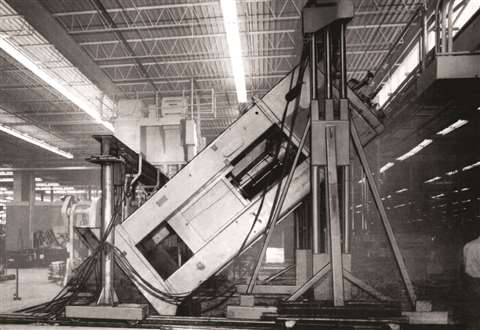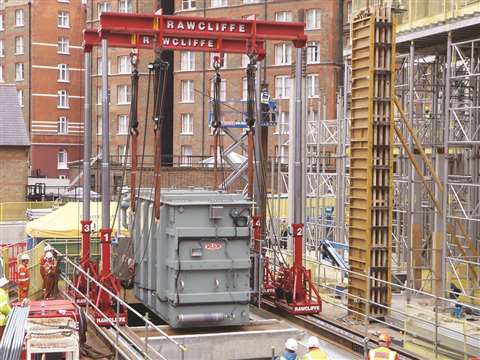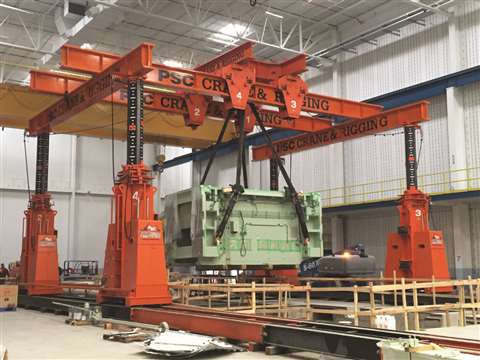Celebrating the 60th anniversary of the hydraulic gantry system
12 April 2023
Sixty years ago, the rigging world was introduced to a new type of lifting equipment: the hydraulic gantry system. Originally developed to facilitate the lifting of heavy equipment inside plant buildings when overhead cranes of adequate capacity were not available, the hydraulic gantry system has grown dramatically in both capability and in application to a wide variety of rigging tasks. We will mark this diamond anniversary of the hydraulic gantry system with a look back and a look ahead.
 Figure 1: The first hydraulic gantry system.
Figure 1: The first hydraulic gantry system.
Where we came from
The first hydraulic gantry system was designed and built in 1963 by Belding Engineering Company of West Chicago, IL. The design was driven by the need to dismantle a number of tall presses inside a sink factory. Figure 1 is a photograph of that first gantry system at work laying down a press. While this first system was downright primitive by today’s standards, it served to demonstrate the concept and prove the effectiveness of the equipment. As a side note, this first Belding gantry system is now owned by Rigging Gear Sales.
Throughout the 1960s and 1970s, other companies designed and built gantry systems, including a one-of-a-kind 600-ton capacity four-leg system built and operated by one of the author’s early employers, Williams Crane & Rigging.
All of these early gantry systems shared one trait: They all used single-stage cylinders. A major improvement occurred in the late 1970s when Edgar Engler built a gantry system that utilized three five-stage telescopic hydraulic cylinders in each leg. This simple change enabled gantry legs to be configured for practical over the road transport and yet be capable of much greater lift heights. This development also brought together Mr. Engler, Roger Johnston, P.E. and Gary Lorenz. Together, these three men founded Riggers Manufacturing Company, the first of the current generation of gantry system manufacturers. Riggers built gantry systems using the basic concept of Engler’s system, but added many refinements including wheels, propel cylinders and a leveling system.
In the mid-1980s, Lorenz left Riggers and founded 4-Point Lift Systems (now Lift Systems) and Johnston left Riggers and established J&R Engineering Company, his existing consulting engineering firm, as a gantry system manufacturer. And now, the competition was on.
Where we are today
The path taken by the manufacturers of hydraulic gantry systems is not unlike that taken by mobile crane manufacturers. In a very broad summary, gantry systems increased in rated load and in lift height. The original Belding gantry system had a rated load of only 37.5 tons per leg and a stroke of 8 feet.
 Figure 2: A Lift Systems Mini-Jacks bare cylinder gantry system.
Figure 2: A Lift Systems Mini-Jacks bare cylinder gantry system.
Current gantry models have rated loads as high as 345 tons per leg and strokes of as much as 29 feet. Further, gantry products are split along two basic designs. Bare cylinder gantries, like the Belding gantry, consist of a structural base on which are mounted exposed hydraulic cylinders. Telescopic boom gantries consist of a base on which is mounted a structural steel boom, not unlike the boom of a hydraulic crane in appearance and function, in which is enclosed the hydraulic cylinder. These differences in configuration allow gantry models to be manufactured as lightweight bare cylinder legs that are easy to transport and set up for smaller jobs (Figure 2) to higher capacity telescopic boom gantries (Figure 3) for heavier lifts.
Gantry systems have also been enhanced with the addition of accessory hardware that facilitates the positioning of the lifted load. The gantry system shown in Figure 3 is equipped with powered lift links that allow transverse movement (side shifting) and a rotator device that allows spinning of the suspended load. Accessories like these further enhance the utility of a gantry system.
Perhaps as significant as the increases in capacity and height are the changes made to the control systems. Early on, a gantry system was operated by manipulating simple lever-controlled hydraulic valves, the plumb of the legs was monitored visually or with a transit and the only indictor of the load carried by each leg was the fluid pressure in each cylinder as read on an analog gage. Today, electronics rule.
Gantry system controls may now include electronic devices that monitor the load carried by each leg, that measure the extension of each leg and that measure the travel and side shift motions of the system. The more sophisticated control systems incorporate logic routines that utilize the information from the various sensors on the gantry legs to automatically synchronize all of the motions of the legs during a lifting operation. Wireless control units are also increasingly available, a feature that allows the operator to move around the equipment during a lift to get the best view of the gantry system, the lifted load and any surrounding obstructions.
A cautionary comment is needed here. These electronic controls are unquestionably a great improvement over the simple manual controls of the past. However, they do not replace the need for a suitably trained and experienced operator. Just like the LMIs and anti-two-block devices that are now on mobile cranes, these load and height indicators on gantry systems must be recognized as operator aids. Final responsibility for safe lifting still remains with the operator whose hands are on the controls, whether those controls are levers or touch screens.
Where we are going
Four manufacturers of hydraulic gantry systems are active in the U.S., the three legacy manufacturers (Riggers Manufacturing, J&R Engineering and Lift Systems) and Enerpac (formerly Hydrospex). Given the creativity seen in the products offered today, we can only guess at what tomorrow will bring.
 Figure 3: A J&R Engineering telescopic boom gantry system.
Figure 3: A J&R Engineering telescopic boom gantry system.
Further increases in rated loads will likely not progress as much in the future as in the past. This trend may be driven not by the limitations of the equipment, but by limitations in the ability to support a gantry leg that is supporting, say, 500 tons. (As a point of reference, think about the load spreading required to support a mobile crane like the Grove GMK7550 that may impose outrigger loads in excess of 250,000 pounds.)
Increases in gantry leg stroke (retracted height to fully extended height) will likely continue, since this aspect of gantry performance is of great value to gantry users. However, going much above the current maximum heights of around 40 feet will be accompanied by increased track widths to provide adequate stability. While the narrow profile of many gantry leg models is important when working in a constricted manufacturing plant, this is not of great significance when working in a construction environment. It is noted that some gantry models already are proportioned to run on track with 4-foot beam centers, rather than the more common 3 feet.
The march toward increased control system sophistication will continue, just as it has on mobile cranes. The gains in productivity and safety provided by today’s electronic control systems will be built upon as improvements in the available hardware and software are developed.
All in all, we have come a long way in sixty years. The demands of rigging contractors, the creativity of equipment designers and competition among the gantry system manufacturers ensures us that we will continue to progress in the years to come.

David Duerr, P.E. (ret.), president of 2DM Associates, entered the rigging industry in 1974 in the employ of Hoffman International and has since worked for VSL Corporation, Williams Crane & Rigging and McDermott International. He founded 2DM Associates in 1986. Duerr is a member of the ASME B30.1 and B30.20 Subcommittees, a contributing member of the ASME P30 Committee and has been a member of the ASME BTH Committee since its inception. He is the author of Telescopic Hydraulic Gantry Systems, a comprehensive guide to lift planning and engineering for hydraulic gantry systems, and the Mobile Crane Support Handbook, a definitive guide to the engineering of support systems for mobile cranes.
Suggested reading
The following publications are very useful references for users of hydraulic gantry systems.
- ASME B30.1-2020 Jacks, Industrial Rollers, Air Casters, and Hydraulic Gantries (for users in the U.S.), www.asme.org
- BS 7121-13:2009 Code of Practice for Safe Use of Cranes: Hydraulic Gantry Lifting Systems (for users in the U.K.), www.en-standard.eu
- Recommended Practices for Telescopic Hydraulic Gantry Systems, Specialized Carriers and Rigging Association, https://www.scranet.org/
- Telescopic Hydraulic Gantry Systems, David Duerr, https://store.iti.com




